Migrating with Monarchs
Monday, November 28th, 2022 at 11:37 am by Jim LovettFiled under Monarch Migration | Comments Off on Migrating with Monarchs
by Denise Gibbs
Currently, I am a Monarch Conservation Specialist for Monarch Watch. Before that, I had a career as an interpretive naturalist, native plant nursery owner specializing in nectar and host species for butterflies, and teacher of a graduate course focused on butterfly conservation. But by far, my most satisfying endeavor (at the late Dr. Lincoln Brower’s urging) was researching Monarch migration and roosting behavior for the Chincoteague Monarch Monitoring Project at Chincoteague National Wildlife Refuge and Assateague Island National Seashore on Assateague Island, Virginia. For 23 fall seasons (mid-Sept to late Oct) I collected quantitative data from a 3X daily Pollard transect (driving census) on refuge roads, a daily point count on the primary dune, and 3X weekly count from the top of a hawk watch tower. In between, I netted and tagged Monarchs. I also conducted impromptu Monarch interpretation and tagging demonstrations for visitors on the beach and on the refuge’s tram tour. The data and my recommendations were included in a Monarch management plan for the refuge which was implemented and continues to benefit migratory Monarchs utilizing the refuge’s resources. But there was just one thing missing. I wanted to know where the Monarchs went after they left the island. I wanted to witness and experience the next phase of their journey…
From mid-Sept to late October 2022, my husband Rob and I journeyed along with Monarchs as they migrated along the Atlantic and Gulf coasts.
The day we left our home in the Verde Valley of central Arizona, our yard was nurturing all life stages of Monarchs. I wished them well and we headed north on I-17, which was lined in fields of gold — sunflowers, goldenrod, golden crownbeard, and goldeneye. AZ had an abundant and extended monsoon season this year — wildflowers and butterflies (including Monarchs) flourished. From Flagstaff, we drove on I-40 toward the East coast. As we traveled, high winds from the south were so strong we feared that Swan (our tall campervan) might be blown into other lanes on overpasses and bridges. Rob drove and I watched for migrating monarchs, but saw none; the wind was not favorable for Monarch flight southward. We drove through 9 states, but I didn’t see a migrating Monarch until a week later in downtown Norfolk, Virginia.
After that, we saw Monarchs every day at every place we stopped. We had several good Monarch migration days on the Delmarva peninsula and its barrier islands — at Assateague Island State Park in MD and Chincoteague National Wildlife Refuge (CNWR) in VA, before we got slammed with Hurricane Ian’s gale-force winds and coastal flooding. The rain was needed. 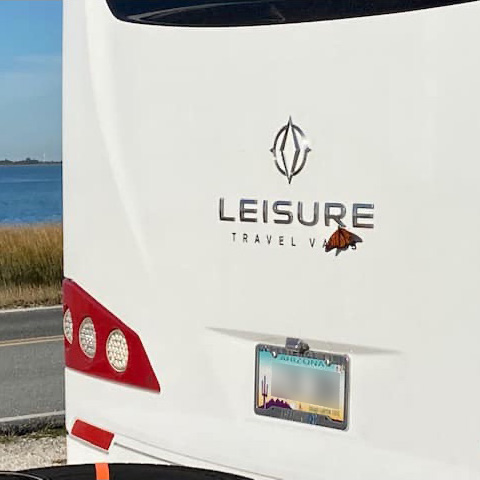 Past years’ wet fields and ditches of Bur-marigold (Bidens laevis) were dry and barren this year. The rains came too late for them, but boosted the blooms of Seaside goldenrod (Solidago sempervirens), which were already late in opening their flowers. The first big wave of migrating Monarchs had to fly further inland from their migratory path along the beach to find the other two species of goldenrod that were in bloom: Slender and Grass-leaved. Groundsel-tree (Baccharis halimifolia) was beginning its bloom and was utilized by migrating Monarchs as well. As usual at CNWR, the wind was variable, and on most days the Monarchs flew (constantly flapping) in less-than-ideal winds. They stopped often to rest in places protected from the wind. Beach parking was limited after the hurricane removed all the public parking lots, so we had to park Swan along the narrow, exposed causeway. This proved to be fortunate for the Monarchs, because they used the vehicle as a wind block and as a place to rest (see photo).
Past years’ wet fields and ditches of Bur-marigold (Bidens laevis) were dry and barren this year. The rains came too late for them, but boosted the blooms of Seaside goldenrod (Solidago sempervirens), which were already late in opening their flowers. The first big wave of migrating Monarchs had to fly further inland from their migratory path along the beach to find the other two species of goldenrod that were in bloom: Slender and Grass-leaved. Groundsel-tree (Baccharis halimifolia) was beginning its bloom and was utilized by migrating Monarchs as well. As usual at CNWR, the wind was variable, and on most days the Monarchs flew (constantly flapping) in less-than-ideal winds. They stopped often to rest in places protected from the wind. Beach parking was limited after the hurricane removed all the public parking lots, so we had to park Swan along the narrow, exposed causeway. This proved to be fortunate for the Monarchs, because they used the vehicle as a wind block and as a place to rest (see photo).
When Bayberry/Groundsel-tree thickets were available, Monarchs would take refuge from the wind in the dense vegetation. But if they rode the wind to the over-washed beach area, they had to find other ways to avoid being blown out over the ocean. On a day with a 20-30 mph NW wind, a Monarch wedged itself in a crack in a wooden board along the saltmarsh boardwalk trail, while others clung to short plant stems on the beach (see photos below).
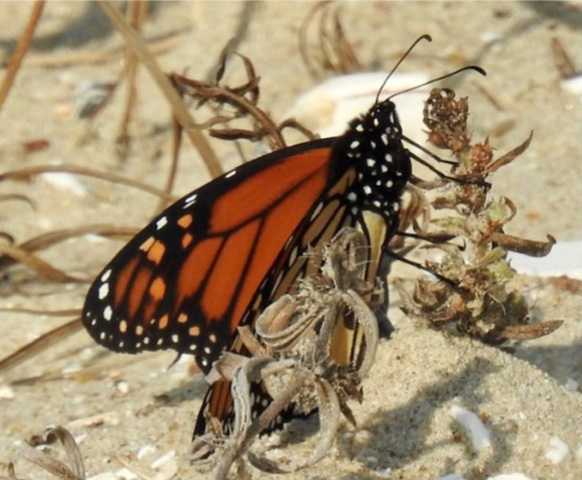
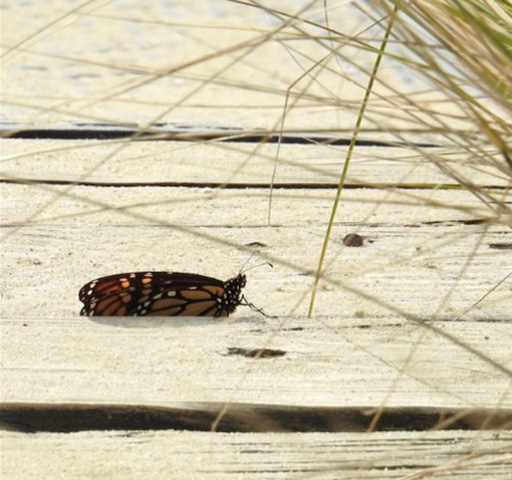
We left Virginia’s barrier islands and headed south, stopping to camp the first night at Kiptopeke State Park, which is at the southern tip of the Delmarva. With south winds, Monarchs were bottled-up, waiting for a north wind that would carry them safely and swiftly across the Chesapeake Bay to Virginia Beach. (We learned from a friend that their departure en mass actually occurred 5 days after we had left). In the photos below, Monarchs were hunkered down in the Bayberry thickets along the Eastern shore of the Chesapeake Bay when they were not nectaring on the abundant patches of Seaside goldenrod.
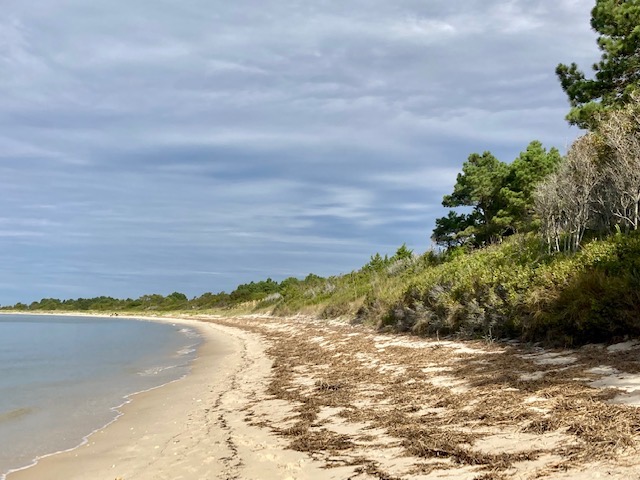
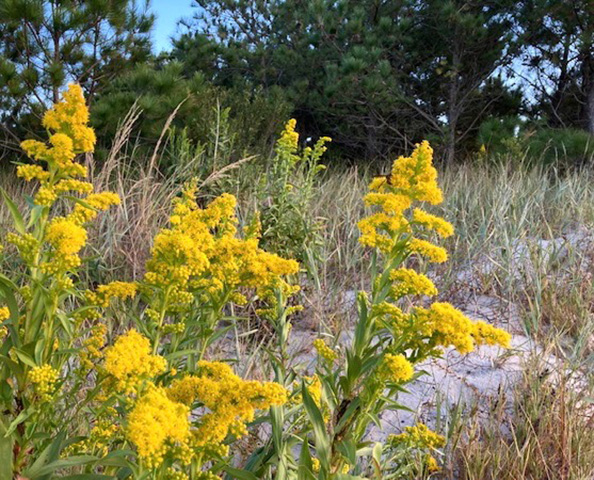
We headed south toward Florida, following coastal routes. We stopped at nature centers, welcome centers, and visitor centers. It was encouraging to see that every one of them had a pollinator garden. Some were simply wild patches they had allowed to grow; others were intentionally planted small token gardens, and a few had extensive professionally-designed beds. I did not see any Monarch Waystation signs, but I did see plenty of Monarchs in every garden. Nectar sources included native asters, goldenrods, and Blue mistflower. Only a few gardens contained milkweed— Butterfly weed and/or Tropical milkweed.
We also stopped frequently at every town that had available RV parking (with easy access to the ocean or a bay) to look for Monarchs. We saw them at EVERY place we stopped in VA, NC, SC, and GA. Back Bay NWR in VA was particularly good. Most often, the Monarchs we saw were refueling in patches of goldenrod instead of migrating. We hit the Monarch jackpot on a N wind day at Huntington Beach State Park in SC — a continuous stream of Monarchs flying low (10-20′ high) over the dry sand portion of the beach on a perfect N wind. There easily could have been 10,000 Monarchs by the end of the day (see photo).
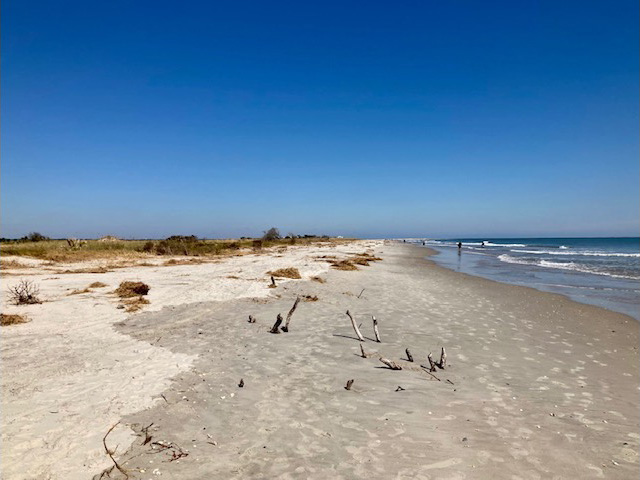
Our final stop on the Atlantic coast was the beach at Tybee Island GA, but saw only a few Monarchs in a town-square pollinator garden with Lantana and Tropical milkweed. We turned inland, avoided the interstate, and took alternate routes to St Mark’s National Wildlife Refuge in FL. Roadside nectar sources were abundant but we saw only a few monarchs en route. We spent 2 days at the refuge. Winds were SW or S, so we saw no migrating monarchs — just those that were bottled-up at Lighthouse Point, nectaring on goldenrod, and waiting for the wind direction to shift in their favor. Gulf fritillaries by the hundreds kept the nectaring Monarchs company (see photos below).

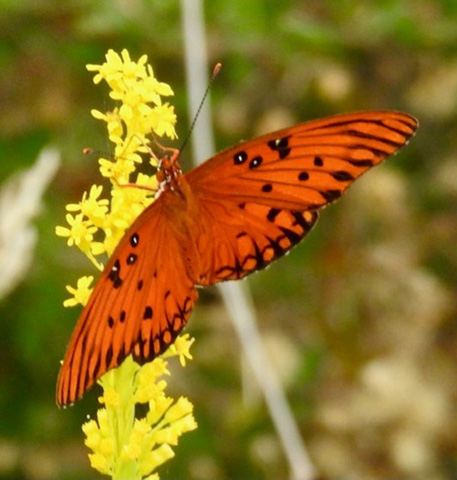
The gulf coast from Florida to Texas was surprisingly good. We saw Monarchs everywhere we stopped to look for them. At Point Park Pascagoula, MS (near the birthplace of Jimmy Buffett), we hit another Monarch jackpot. In the 30 minutes that I walked down Buffett Beach, I counted over 1000 monarchs as they flew past me at eye level on a 10-20 mph N wind. Once they reached the point, they stopped to nectar in a dense thicket of Groundsel-tree. There were thousands still nectaring in those thickets when we left at dusk.
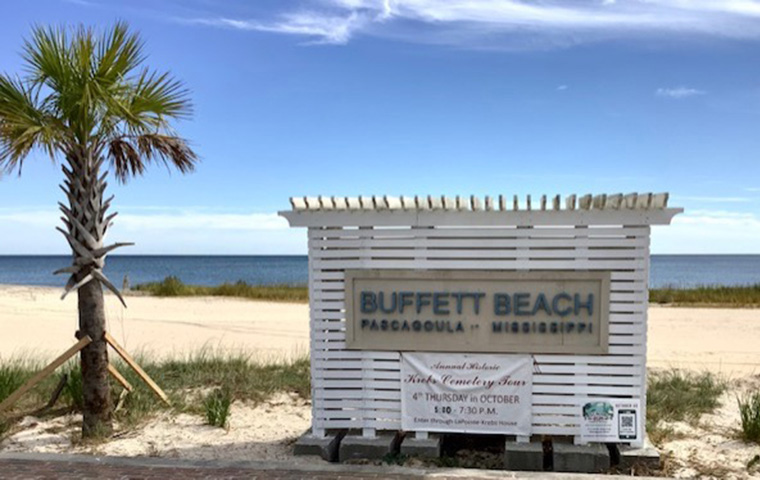
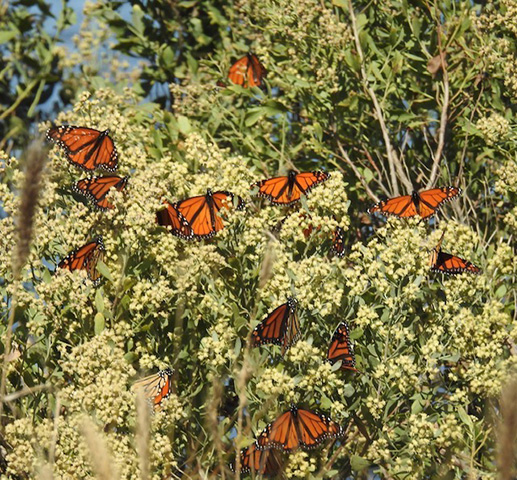
Our last stop on the gulf coast was at Sea Rim State Park, TX (NE of Galveston). We arrived at 3:30 PM and made a beeline for the beach. Low tide revealed a wide flat beach where Monarchs were migrating. I counted 52 from 4-4:30. (That was close to the number that Harlen had counted on his driving census along Lavaca Bay the same day). Then at 4:30, Monarchs started dropping down into a wide flat dune area full of goldenrod and other wildflowers. I counted a few hundred nectaring, but the area was so extensive (about 100 x 300 yards) that there were likely many more I couldn’t see. While searching, I found this pair mating (see photos).
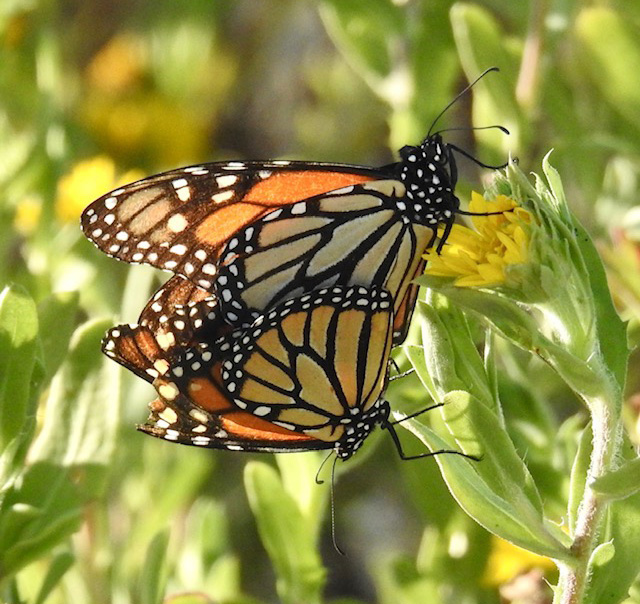
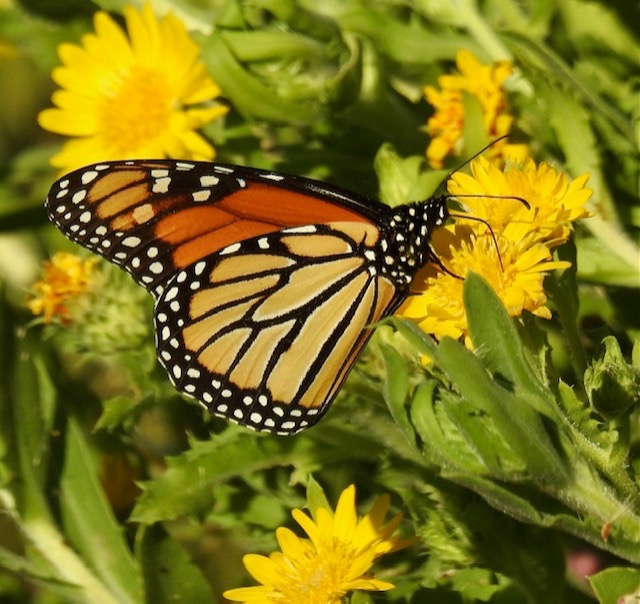
Reluctantly, we left the Gulf coast and drove west on I-10 across Texas. We continued to see monarchs crossing the highway from north to south, particularly in the Texas Hill Country. In Kerrville, Monarchs were migrating along the Guadalupe River, stopping to nectar on Bidens and Blue mistflower (see photos below). The last migrating Monarch we saw in TX was in Ozona.
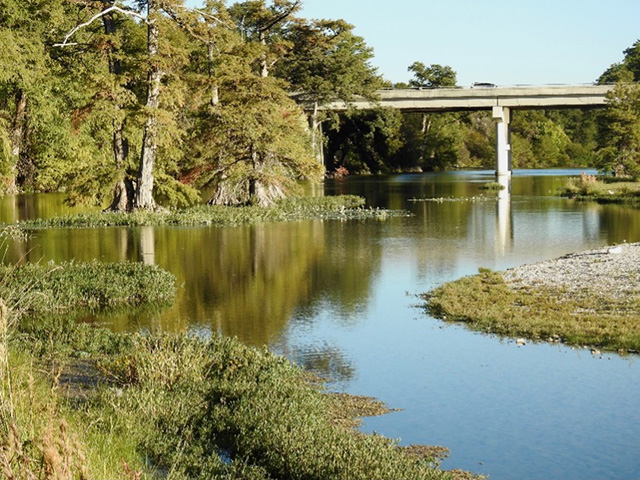
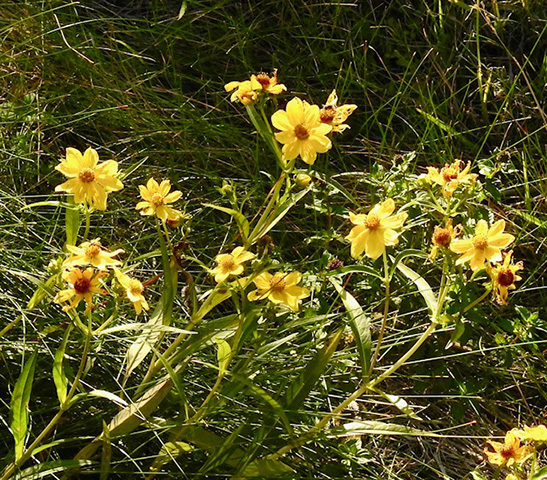
We crossed the state line into New Mexico on Oct 21. I continued to watch for those orange beauties as we drove west toward AZ. We saw no Monarchs in NM. There had already been below-freezing night temperatures and the roadside wildflowers were dead. Another cold front the next day caused the temperature to plummet, and snow was in the forecast for AZ’s White Mountains (our intended route home). Instead we stayed on I-10 to avoid the snow. We stopped in Wilcox to watch the arrival of thousands of Sandhill Cranes. Fleabane and Tansyaster were still blooming around the playa and were luring in Variegated fritillaries, Checkered whites, Queens, Checkered and Fiery skippers — but no Monarchs. Our final campsite of the trip was in the Sonoran Desert near Tucson. There were plenty of Monarchs present, so I felt like we had come full circle.
Final thoughts:
From 23 Fall seasons of watching migratory behaviors of Monarchs on Assateague Island, I already had a deep respect and appreciation for their ability to endure hardships and survive hurricanes, nor’easters, and flooded roosting sites. But all along this trip route, I was in awe of their continued resilience. Their ability to keep migrating despite obstacles was astonishing. They flapped directly into SW and S winds, endured long distances with a scarcity of nectar sources, and hunkered down on days with torrential rain, cold temperatures, gale-force winds, and coastal flooding. Along the Gulf coast they flew over developed beaches with no habitat, through the hazy polluted stench of paper mill exhaust, and over shipyards blasting ear-shattering horns and sirens. They took shelter in the most unlikely and inhospitable places. They got blown backwards or out over the ocean on extremely unfavorable winds, but kept flapping to stay true to their directional flight. The migratory urge (compulsion, drive, stimulus — however you want to describe it) keeps them going — against all odds. There’s a lesson in that for all of us.
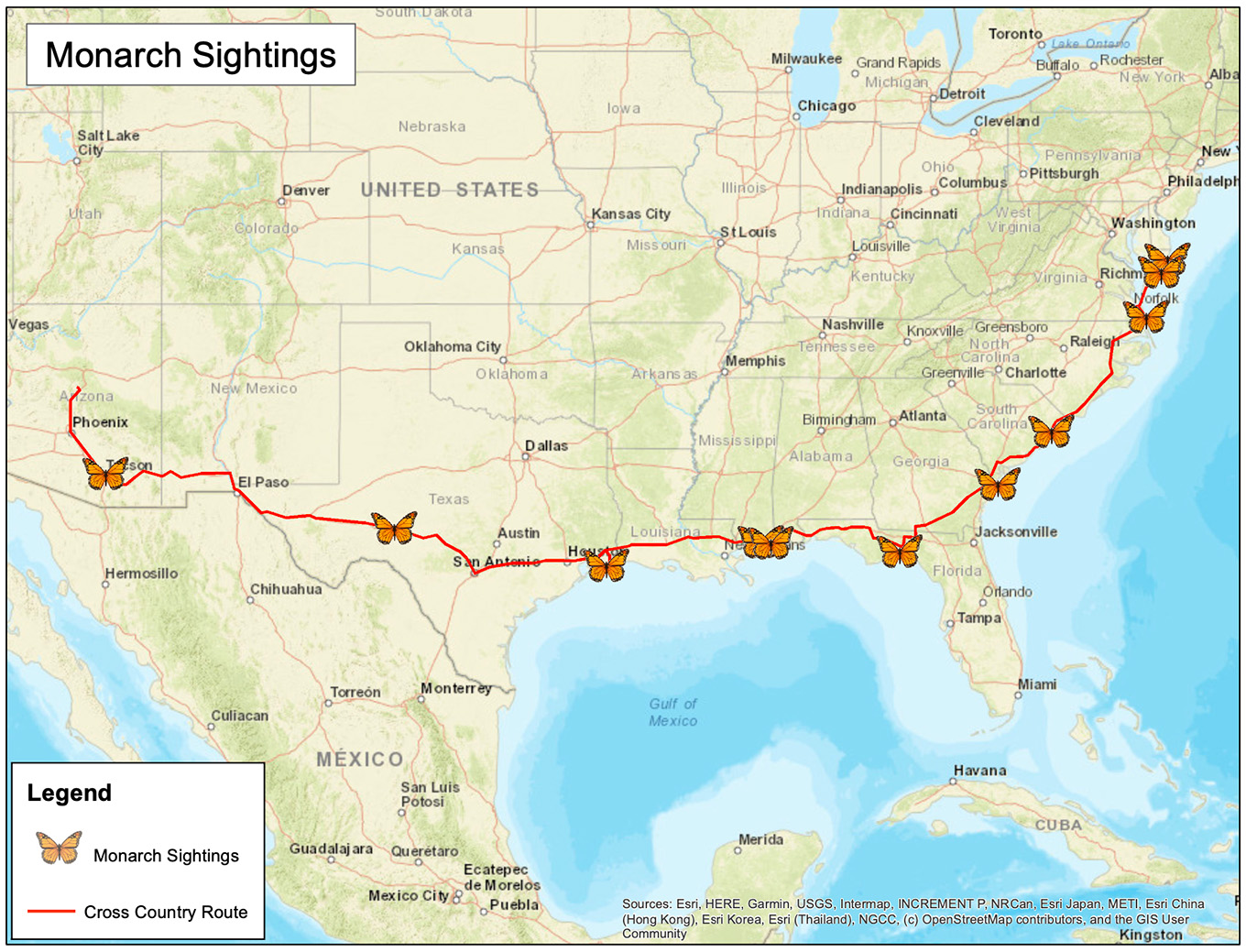
Monarch icons indicate locations with significant numbers of Monarchs — either migrating, nectaring, roosting, or all three.


Sorry, comments for this entry are closed at this time.